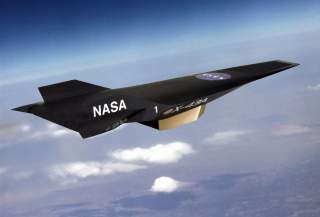Get Ready, China: Japan is Joining the Hypersonic Missile Club
And Beijing won't be happy.
Japan is developing its own hypersonic missile. Tokyo has allocated about $57 million in the 2019 defense budget to develop hypersonic weapons—which achieve speeds of Mach 5 or greater—according to UPI, citing Japan’s Kyodo News.
“Japan’s defense ministry plans to build a prototype of a scramjet engine and research technologies for burning jet fuel during high-speed flight, as well as technology for heat-resistant materials,” UPI said. “Tests will take place from 2023 to 2025.”
Significantly, Japan’s Defense Ministry said: “the missile will be used for the ’defense of the island’ and will not be used the way they are deployed in the U.S. military.”
Meanwhile, Japan is also developing a supersonic, missile-launched glide bomb. Fired from a mobile launcher, the missile lofts the bomb to 65,000 feet, enabling the bomb to plunge earthward at supersonic speed. Japan is accelerating development of that weapon for deployment by 2026. The glide bomb will be used to defend Japan’s outlying islands around Okinawa such as the Senkakus, which are claimed by China. Japan is also considering whether to deploy anti-ship missiles to the disputed islands and has created an amphibious rapid deployment brigade that will use missiles to defend or recapture these islands.
Japan also wants to buy cruise missiles, including America’s Joint Air-to-Surface Standoff Missile-Extended Range (JASSM-ER) and the Norwegian/U.S. Joint Strike Missile. These weapons could be used to destroy North Korean ballistic missiles aimed at Japan.
Missiles tend to make people nervous, but none more so than Japan. Like Germany, Japan still labors under its World War II legacy of fascist aggression (which its neighbor China isn’t likely to let them forget). Additionally, Japan’s 1947 constitution outlaws war as a means of settling international disputes, and Japan’s military is named the Japan Self Defense Force.
But hypersonic missiles tend to be perceived as offensive weapons because of their high speed, which makes them useful for surprise attacks. Long-range cruise missiles (the JASSM-ER has a range of more than 575 miles) and high-altitude glide bombs can also hit distant targets with great accuracy. Furthermore, for nuclear-armed powers, hypersonic missiles are a menace, because they raise the possibility that a foe could use high-speed missiles—even armed with conventional warheads—to destroy their nuclear missiles in a quick first strike.
“The [hypersonic] missile Japan seeks to develop is capable of attacking enemy bases,” UPI noted. “Concerns are rising they violate the principles of the country’s defense-oriented policy under the constitution.”
Japan armed with high-speed or long-range weapons will certainly increase the tension in an already-paranoid North Korea, which fears a surprise attack aimed at its missiles, nuclear weapons and leaders. But it is China, armed with a formidable nuclear arsenal and a large conventional military to match that could get nervous. The same could be said for Russia, which also has outstanding territorial disputes with Japan.
Recommended: What Will the Sixth-Generation Jet Fighter Look Like?
Recommended: Imagine a U.S. Air Force That Never Built the B-52 Bomber
Recommended: Russia's Next Big Military Sale - To Mexico?
Recommended: Would China Really Invade Taiwan?
Both China and Russia are busily developing their own hypersonic missiles. Japan’s entry into the hypersonic club is not illogical. As a major power, even one that is ostensibly anti-war, Japan cannot remain immune from changes in military technology. For better or worse, hypersonic missiles are coming, and so is a hypersonic arms race between America, Russia and China. Perhaps Japan will now join the race.
Michael Peck is a contributing writer for the National Interest. He can be found on Twitter and Facebook.
Image: Reuters


